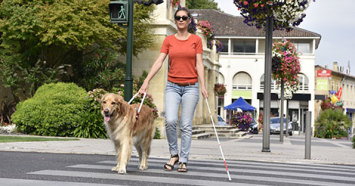
Guide dogs, or seeing eye dogs, are a special breed. They complete rigorous training in order to help blind or visually impaired people navigate their every day lives independently. One of my uncles was blind for the final twenty years or so years of his life, and I saw firsthand the benefits he received by having guide dogs. It’s really an amazing partnership to reflect upon and witness.
What is a guide dog?
A guide dog is a specially-trained working dog whose job it is to work with their blind or visually-impaired handler to get around obstacles and make it from point A to point B as they go out and about in the world. The guide dog doesn’t exist in a vacuum; the dog is one-half of the pair, and both handler and dog need each other to accomplish the goal of getting somewhere successfully and safely. The human handler gives commands based on their knowledge of where the pair needs to go, and the dog prevents them from getting in harm’s way by choosing the path or stopping altogether. The dog wears a rigid u-shaped harness and often a vest that indicates they are a guide dog. Although Labs, German Shepherds, and Golden Retrievers are commonly used in guide dog training programs, the breed of dog doesn’t matter. What matters is size, temperament, and a few other characteristics and skills.
What qualities does a good guide dog need?
There are several main elements that make a dog a good guide dog:
Temperament– Guide dogs must be trainable, calm, friendly, and unflappable in all environments. They must be focused and confident in busy and confusing situations, and be willing to work, have the desire to achieve, and thrive on praise. Guide dogs cannot be aggressive or anxious at all.
Size– Guide dogs for blind or visually-impaired people need to be large and robust enough to be able to physically stop their handler from moving when there is a dangerous obstacle. They also need to be small enough to fit comfortably under or next to most chairs, desks, tables, and on mass transit without blocking too much foot traffic.
Intelligence– One of the main tasks of a guide dog is to “intelligently disobey” their handler. This means that if the handler gives the dog a command that would lead the pair into the path of danger, the dog has to be able to analyze the situation first and know enough to not obey. This will signal the handler to wait or redirect the pair to take a different route.
Health– The dog must be as healthy and injury-free as possible. If the puppy or dog becomes seriously ill or injured during training or assignment, they will be retired. In order to be able to do their job, they must be in tip-top condition at all times. This also means their handler must take care to feed them properly, groom them, take them to the vet, and tend to any needs they have.
What happens during guide dog training? How long does it take?
There are many guide dog training programs all over the world, and each runs their particular program in their own way. Overall, they mostly follow the same big plan:
Puppies enter the program when they are young – between 8-10 weeks typically.
They are assigned to a guide dog puppy raiser. These are folks who have trained to train and assess the puppies in basic obedience and social skills.
The puppy lives and trains with the puppy raiser for a year or more.
The dog enters formal training for another few months, where they learn skills specific to working with blind or visually impaired people.
Once they complete their training, the dog is matched up with the handler they are intended to work with for life. The pair goes through training and practice together for several weeks or months.
At the end of their time together, the handler and dog go through an assessment. If they pass, they get to graduate the program and go on to live their lives together!
If a puppy or dog is released early from the training program for lack of fit, they most likely are reassigned to a different program or role that is more suited to their skills. Service dogs can perform all sorts of duties from emotional support and therapy to detecting seizures.
What specific skills do guide dogs perform?
There is no limit to what a guide dog can learn to do if given time and training. Some of the most common tasks a guide dog learns are:
How do you get a guide dog?
Leading the handler in a straight line from one point to a given destination
Stopping for all changes in elevation, including curbs and stairs
Stopping for overhead obstacles, such as tree limbs
Avoiding obstacles in their path
Ignoring distractions that interfere with their job
Exhibiting good manners at all times
How do you get a guide dog?
There are many organizations that provide fully-trained and certified guide dogs at no charge to people who need them. Again, each organization has its own process, but typically anyone who is interested in a guide dog has to fill out an application, go through an interview, and then go through an evaluation and matching process. Once accepted and matched, the person begins training with their dog.
Aren’t you just amazed? I am. Not only do these dogs perform truly life-changing skills, they make sweet, loving companions. This can be especially vital for people who might otherwise feel alone in their experience. Living and working so closely together fosters a deep bond between handler and dog that enriches both of their lives. I saw it firsthand with my uncle, and I know it’s the same for thousands of people and dogs all over the world.